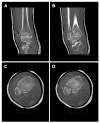Syndesmotic Internal BraceTM for anatomic distal tibiofibular ligament augmentation
- PMID: 28473957
- PMCID: PMC5396014
- DOI: 10.5312/wjo.v8.i4.301
Syndesmotic Internal BraceTM for anatomic distal tibiofibular ligament augmentation
Abstract
Reconstruction of unstable syndesmotic injuries is not trivial, and there is no generally accepted treatment guidelines. Thus, there still remain considerable controversies regarding diagnosis, classification and treatment of syndesmotic injuries. Syndesmotic malreduction is the most common indication for early re-operation after ankle fracture surgery, and widening of the ankle mortise by only 1 mm decreases the contact area of the tibiotalar joint by 42%. Outcome of ankle fractures with syndesmosis injury is worse than without, even after surgical syndesmotic stabilization. This may be due to a high incidence of syndesmotic malreduction revealed by increasing postoperative computed tomography controls. Therefore, even open visualization of the syndesmosis during the reduction maneuver has been recommended. Thus, the most important clinical predictor of outcome is consistently reported as accuracy of anatomic reduction of the injured syndesmosis. In this context the TightRope® system is reported to have advantages compared to classical syndesmotic screws. However, rotational instability of the distal fibula cannot be safely limited by use of 1 or even 2 TightRopes®. Therefore, we developed a new syndesmotic InternalBraceTM technique for improved anatomic distal tibiofibular ligament augmentation to protect healing of the injured native ligaments. The InternalBraceTM technique was developed by Gordon Mackay from Scotland in 2012 using SwiveLocks® for knotless aperture fixation of a FiberTape® at the anatomic footprints of the augmented ligaments, and augmentation of the anterior talofibular ligament, the deltoid ligament, the spring ligament and the medial collateral ligaments of the knee have been published so far. According to the individual injury pattern, patients can either be treated by the new syndesmotic InternalBraceTM technique alone as a single anterior stabilization, or in combination with one posteriorly directed TightRope® as a double stabilization, or in combination with one TightRope® and a posterolateral malleolar screw fixation as a triple stabilization. Moreover, the syndesmotic InternalBraceTM technique is suitable for anatomic refixation of displaced bony avulsion fragments too small for screw fixation and for indirect reduction of small posterolateral tibial avulsion fragments by anatomic reduction of the anterior syndesmosis with an InternalBraceTM after osteosynthesis of the distal fibula. In this paper, comprehensively illustrated clinical examples show that anatomic reconstruction with rotational stabilization of the syndesmosis can be realized by use of our new syndesmotic InternalBraceTM technique. A clinical trial for evaluation of the functional outcomes has been started at our hospital.
Keywords: Anatomic repair; InternalBraceTM; Rotational instability; Stabilization; Surgical technique; Syndesmosis injury.
Conflict of interest statement
Conflict-of-interest statement: Markus Regauer and Gordon Mackay are paid consultants of Arthrex (Naples, Florida, United States).
Figures
















Similar articles
-
Anatomy of the distal tibiofibular syndesmosis in adults: a pictorial essay with a multimodality approach.J Anat. 2010 Dec;217(6):633-45. doi: 10.1111/j.1469-7580.2010.01302.x. J Anat. 2010. PMID: 21108526 Free PMC article. Review.
-
Chronic Syndesmotic Instability Associated with a Complex Lesion of the Posterior Inferior Tibiofibular Ligament: Review, Case Report, and Surgical Report.J Orthop Case Rep. 2025 Aug;15(8):256-259. doi: 10.13107/jocr.2025.v15.i08.5960. J Orthop Case Rep. 2025. PMID: 40786813 Free PMC article.
-
A prospective randomised study comparing TightRope and syndesmotic screw fixation for accuracy and maintenance of syndesmotic reduction assessed with bilateral computed tomography.Injury. 2015;46(6):1119-26. doi: 10.1016/j.injury.2015.02.004. Epub 2015 Feb 21. Injury. 2015. PMID: 25769201 Clinical Trial.
-
[Injuries of the inferior tibiofibular syndesmosis].Unfallchirurg. 2000 Jul;103(7):520-32. Unfallchirurg. 2000. PMID: 10969538 Review. German.
-
Anterior-inferior tibiofibular ligament anatomical repair and augmentation versus trans-syndesmosis screw fixation for the syndesmotic instability in external-rotation type ankle fracture with posterior malleolus involvement: A prospective and comparative study.Injury. 2016 Jul;47(7):1574-80. doi: 10.1016/j.injury.2016.04.014. Epub 2016 Apr 21. Injury. 2016. PMID: 27129908 Clinical Trial.
Cited by
-
Trapeziectomy with Ligament Reconstruction/ Suspensionplasty Compared to Suture Tape Suspensionplasty for the Surgical Treatment of Advanced Thumb Carpometacarpal Osteoarthritis.J Hand Surg Glob Online. 2023 Aug 16;5(6):751-756. doi: 10.1016/j.jhsg.2023.07.006. eCollection 2023 Nov. J Hand Surg Glob Online. 2023. PMID: 38106952 Free PMC article.
-
Novel Tape Suture Osteosynthesis for Hyperextension Injuries of the Subaxial Cervical Spine: A Biomechanical Study.In Vivo. 2023 Jan-Feb;37(1):124-131. doi: 10.21873/invivo.13061. In Vivo. 2023. PMID: 36593052 Free PMC article.
-
Anatomical Augmentation Using Suture Tape for Acute Syndesmotic Injury in Maisonneuve Fracture: A Case Report.Medicina (Kaunas). 2023 Mar 25;59(4):652. doi: 10.3390/medicina59040652. Medicina (Kaunas). 2023. PMID: 37109610 Free PMC article.
-
Does syndesmotic fixation technique impact complication rates and functional outcomes measured by PROMIS scores following operative repair of ankle fractures?J Orthop Surg Res. 2025 Aug 6;20(1):730. doi: 10.1186/s13018-025-06137-9. J Orthop Surg Res. 2025. PMID: 40770808 Free PMC article.
-
Tape suture constructs for instabilities of the pubic symphysis: is the idea of motion preservation a suitable treatment option? A cadaver study.Arch Orthop Trauma Surg. 2023 Jun;143(6):3111-3117. doi: 10.1007/s00402-022-04547-6. Epub 2022 Jul 13. Arch Orthop Trauma Surg. 2023. PMID: 35831608 Free PMC article.
References
-
- Jelinek JA, Porter DA. Management of unstable ankle fractures and syndesmosis injuries in athletes. Foot Ankle Clin. 2009;14:277–298. - PubMed
-
- Mackay GM, Blyth MJ, Anthony I, Hopper GP, Ribbans WJ. A review of ligament augmentation with the InternalBrace™: the surgical principle is described for the lateral ankle ligament and ACL repair in particular, and a comprehensive review of other surgical applications and techniques is presented. Surg Technol Int. 2015;26:239–255. - PubMed
-
- Bava E, Charlton T, Thordarson D. Ankle fracture syndesmosis fixation and management: the current practice of orthopedic surgeons. Am J Orthop (Belle Mead NJ) 2010;39:242–246. - PubMed
LinkOut - more resources
Full Text Sources
Other Literature Sources

